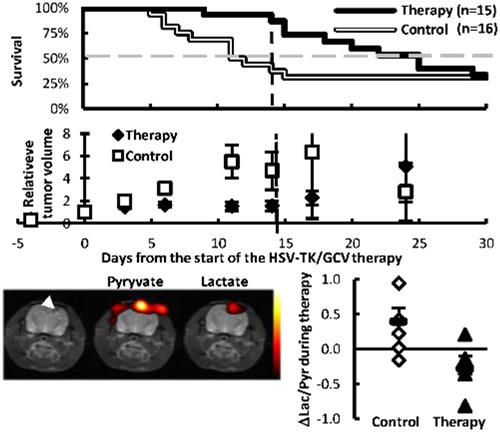当前位置:
X-MOL 学术
›
NMR Biomed.
›
论文详情
Our official English website, www.x-mol.net, welcomes your
feedback! (Note: you will need to create a separate account there.)
Detection of lentiviral suicide gene therapy in C6 rat glioma using hyperpolarised [1-13 C]pyruvate.
NMR in Biomedicine ( IF 2.7 ) Pub Date : 2020-01-07 , DOI: 10.1002/nbm.4250 Riikka Nivajärvi 1 , Venla Olsson 2 , Viivi Hyppönen 1 , Sean Bowen 3 , Hanna M Leinonen 4, 5 , Hanna P Lesch 4, 5 , Jan Henrik Ardenkjaer-Larsen 3 , Olli H J Gröhn 1 , Seppo Ylä-Herttuala 2 , Mikko I Kettunen 1
NMR in Biomedicine ( IF 2.7 ) Pub Date : 2020-01-07 , DOI: 10.1002/nbm.4250 Riikka Nivajärvi 1 , Venla Olsson 2 , Viivi Hyppönen 1 , Sean Bowen 3 , Hanna M Leinonen 4, 5 , Hanna P Lesch 4, 5 , Jan Henrik Ardenkjaer-Larsen 3 , Olli H J Gröhn 1 , Seppo Ylä-Herttuala 2 , Mikko I Kettunen 1
Affiliation

|
Hyperpolarised [1-13 C]pyruvate MRI has shown promise in monitoring therapeutic efficacy in a number of cancers including glioma. In this study, we assessed the pyruvate response to the lentiviral suicide gene therapy of herpes simplex virus-1 thymidine kinase with the prodrug ganciclovir (HSV-TK/GCV) in C6 rat glioma and compared it with traditional MR therapy markers. Female Wistar rats were inoculated with 106 C6 glioma cells. Treated animals received intratumoural lentiviral HSV-TK gene transfers on days 7 and 8 followed by 2-week GCV therapy starting on day 10. Animals were repeatedly imaged during therapy using volumetric MRI, diffusion and relaxation mapping, as well as metabolic [1-13 C]pyruvate MRS imaging. Survival (measured as time before animals reached a humane endpoint and were euthanised) was assessed up to day 30 posttherapy. HSV-TK/GCV gene therapy lengthened the median survival time from 12 to 25 days. This was accompanied by an apparent tumour growth arrest, but no changes in diffusion or relaxation parameters in treated animals. The metabolic response was more evident in the case-by-case analysis than in the group-level analysis. Treated animals also showed a 37 ± 15% decrease (P < 0.05, n = 5) in lactate-to-pyruvate ratio between therapy weeks, whereas a 44 ± 18% increase (P < 0.05, n = 6) was observed in control animals. Hyperpolarised [1-13 C]pyruvate MRI can offer complementary metabolic information to traditional MR methods to give a more comprehensive picture of the slowly developing gene therapy response. This may benefit the detection of the successful therapy response in patients.
中文翻译:

使用超极化[1-13 C]丙酮酸盐检测C6大鼠神经胶质瘤的慢病毒自杀基因疗法。
超极化[1-13 C]丙酮酸MRI在监测包括胶质瘤在内的多种癌症的疗效方面显示出了希望。在这项研究中,我们评估了C6大鼠神经胶质瘤中前药更昔洛韦(HSV-TK / GCV)对单纯疱疹病毒1胸苷激酶对慢病毒自杀基因疗法的丙酮酸反应,并将其与传统MR治疗指标进行了比较。用106只C6神经胶质瘤细胞接种雌性Wistar大鼠。治疗的动物在第7天和第8天接受肿瘤内慢病毒HSV-TK基因转移,然后从第10天开始进行2周GCV治疗。在治疗过程中,使用体积MRI,扩散和弛豫图以及代谢对动物重复成像[1-13 C]丙酮化MRS成像。评估直至治疗后第30天的生存期(以动物达到人道终点并被安乐死的时间衡量)。HSV-TK / GCV基因治疗将中位生存时间从12天延长到25天。这伴随着明显的肿瘤生长停滞,但是在治疗的动物中扩散或松弛参数没有变化。在个案分析中,代谢反应比在组水平分析中更为明显。在治疗周之间,经治疗的动物的乳酸/丙酮酸比例也降低了37±15%(P <0.05,n = 5),而对照中观察到了增加了44±18%(P <0.05,n = 6)。动物。超极化[1-13 C]丙酮酸MRI可以为传统MR方法提供补充的代谢信息,从而为缓慢发展的基因治疗反应提供更全面的图像。这可能有利于检测患者的成功治疗反应。
更新日期:2020-03-09
中文翻译:

使用超极化[1-13 C]丙酮酸盐检测C6大鼠神经胶质瘤的慢病毒自杀基因疗法。
超极化[1-13 C]丙酮酸MRI在监测包括胶质瘤在内的多种癌症的疗效方面显示出了希望。在这项研究中,我们评估了C6大鼠神经胶质瘤中前药更昔洛韦(HSV-TK / GCV)对单纯疱疹病毒1胸苷激酶对慢病毒自杀基因疗法的丙酮酸反应,并将其与传统MR治疗指标进行了比较。用106只C6神经胶质瘤细胞接种雌性Wistar大鼠。治疗的动物在第7天和第8天接受肿瘤内慢病毒HSV-TK基因转移,然后从第10天开始进行2周GCV治疗。在治疗过程中,使用体积MRI,扩散和弛豫图以及代谢对动物重复成像[1-13 C]丙酮化MRS成像。评估直至治疗后第30天的生存期(以动物达到人道终点并被安乐死的时间衡量)。HSV-TK / GCV基因治疗将中位生存时间从12天延长到25天。这伴随着明显的肿瘤生长停滞,但是在治疗的动物中扩散或松弛参数没有变化。在个案分析中,代谢反应比在组水平分析中更为明显。在治疗周之间,经治疗的动物的乳酸/丙酮酸比例也降低了37±15%(P <0.05,n = 5),而对照中观察到了增加了44±18%(P <0.05,n = 6)。动物。超极化[1-13 C]丙酮酸MRI可以为传统MR方法提供补充的代谢信息,从而为缓慢发展的基因治疗反应提供更全面的图像。这可能有利于检测患者的成功治疗反应。


















































 京公网安备 11010802027423号
京公网安备 11010802027423号